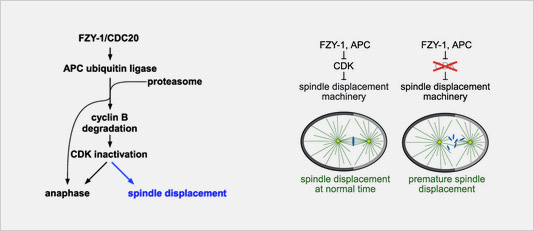Video data from "A
Cell Cycle Timer for Asymmetric Spindle
Positioning"
Erin K. McCarthy
Campbell, Adam D. Werts, Bob Goldstein
| These experiments
demonstrated that APC-dependent negative
regulation of CDK, long known to function as
a mitotic progression timer, serves a second
role as a timer for spindle displacement
during an asymmetric cell division. This
timing mechanism ensures that spindle
assembly is completed before spindle
components begin to move away from the
center of the cell. |


|
Video S1. The Mitotic Spindle
Begins to Shift Approximately
10 s after the Completion of
Chromosome Congression.
Movie of the embryo from Figure
1B–D expressing histone H2B:GFP
and gamma-tubulin:GFP, and a
dynamically annotated version of
the corresponding graph. Dotted
line in the movie marks 50%
embryo length. As the
fluorescence ratio in the center
of the spindle to just outside
this region peaks at metaphase,
displacement of the spindle with
a compact metaphase plate is
evident in the embryo and the
graph. Light blue datapoints in
this graph indicate the center
of the two chromatin masses
after anaphase.
|
|


|
Video S2. Disruption
of Proteasome Activity Delayed
Both Spindle Displacement and
Anaphase Onset. Three
cases of each treatment:
wild-type untreated (top three),
rpt-6(RNAi) (middle
three), and c-LβL (bottom
three). Small regions of each
embryo are shown, each through
most of the mitotic spindle. The
red line is 50% embryo length,
and each movie starts at nuclear
envelope breakdown.
|
|
|
Video
S3. Premature
CDK Inactivation Caused
Premature Spindle Displacement
and Anaphase Onset.
Three cases of each, untreated
(top three) and
flavopiridol-treated (bottom
three). Small regions of each
embryo are shown, each through
most of the mitotic spindle. The
red line is 50% embryo length,
and each movie starts at nuclear
envelope breakdown. Blank frames
are shown at time of
flavopiridol-treatment.
|
|
|
Video
S4. Anaphase
Timing Is Unaffected When
Spindle Displacement Is
Prevented.
WT is wild-type control. The vertical line is
50% embryo length, and each
movie starts at nuclear envelope
breakdown. Spindle displacement
was prevented by par-2
RNAi or gpr-1/2 RNAi.
|
|
|
Video
S5. Flavopiridol
Treatment
as Nuclear Envelope
Breakdown
Began Resulted in Chromosomes
Being Spread over a
Significantly Wider Area Than
Normal at the Time of Spindle
Displacement.
An embryo laser-permeabilized to
flavopiridol as nuclear envelope
breakdown
began (right). Spindle
displacement toward the
posterior (top) and anaphase
both occur before chromosome
congression is complete in the
flavopiridol-treated embryo. The
embryo in the right is the
bottom embryo among the
flavopiridol-treated embryos in
Figure 6A. The embryo on the
left was laser-permeabilized to
flavopiridol later than the
embryo on the right was, and
chromosome dynamics appear less
affected as expected.
|
|
|
Video
S6. Flavopiridol
Treatment
Directly after the Start of Nuclear Envelope
Breakdown Resulted
Sometimes in Individual
Chromosomes Failing to
Associate with a Metaphase
Plate by the Time of Premature
Spindle Displacement.
As in the previous video, but
this is a treated embryo alone,
with an apparently less severe
defect. One chromosome is not
associated with the metaphase
plate during spindle
displacement and anaphase. This
embryo is also shown as the
center embryo among the
flavopiridol-treated embryos in
Figure 6A.
|
|
|
